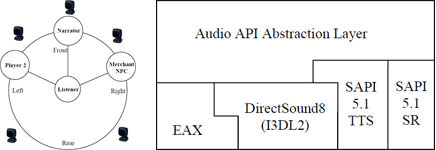The following research includes anything related to game programming that doesn't involve Procedural Content Generation.

Timothy Roden, Ian Parberry, and David Ducrest, "Toward Mobile Entertainment: A Paradigm for Narrative-Based Audio Only Games", Science of Computer Programming , Volume 67, Issue 1, pp. 76-90, June 2007. A preliminary version of this paper appeared in Proceedings of the 2005 ACM SIGCHI International Conference on Advances in Computer Entertainment Technology, Valencia, Spain, pp. 274-277, June 15-17, 2005. [pdf]
Abstract
The widespread use of sophisticated mobile computing devices has set the stage for a renaissance in audio only entertainment. Traditional visual games are already used widely in cellular phones and similar devices. A significant limitation is the small display size. In contrast, audio only games on suitable mobile hardware need not degrade due to the smaller form factor. This makes audio only games an attractive alternative to visual games. We describe a framework for authoring interactive narrative-based audio only games set in 3D virtual environments. Despite the novelty in audio only gaming, our approach builds on a foundation of several years of research into audio only applications for sight impaired users, augmented reality systems and human-computer interaction studies. In comparison to attempts to provide a realistic user interface, we argue a simple interface enhances both immersion and entertainment value, serendipitously making audio only games practical for mobile computing. Novel features of our system include real-time gameplay and multiplayer support. We also describe our software architecture, the current implementation of which uses low-cost existing PC-based hardware and software. In addition, we describe our first game, Dragon's Roar.
Author's Comments
I was asked to give an invited talk on this in 2010. You can see a video of this talk that includes some audio clips from our proof-of-concept games.

